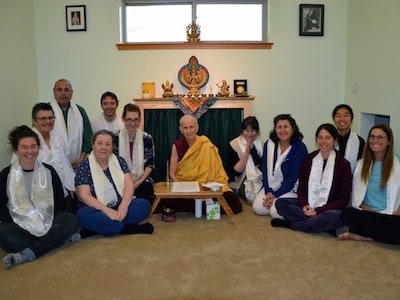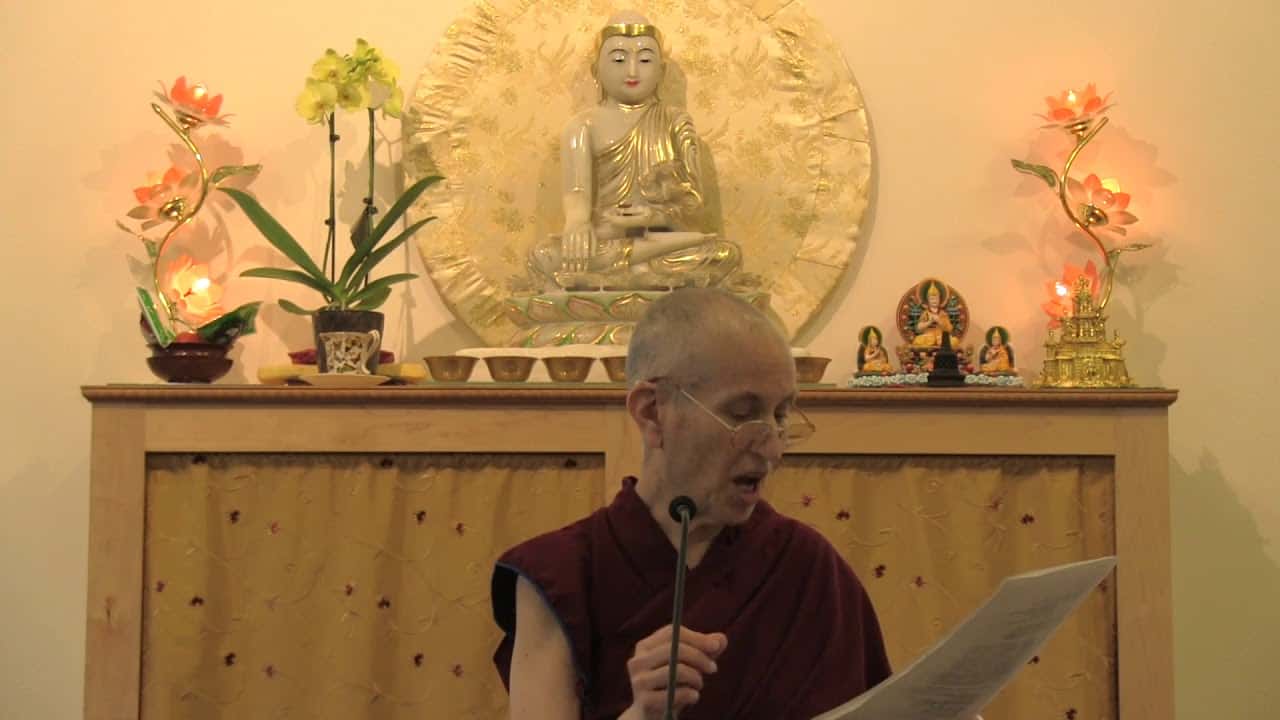The Five Wonderful Precepts: Introduction
From For a Future to be Possible

Although Thich Nhat Hanh’s expanded interpretation and explanation of the five lay precepts differs from that explained by Venerable Chodron, reading and thinking about his explanation can help broaden our understanding and appreciation for what it means to guard our ethical conduct.
“The Five Wonderful Precepts” below are Zen Master Thich Nhat Hanh’s translation of the five basic precepts as taught by the Buddha Shakyamuni. The Buddha offered these precepts to both his ordained and lay followers so that they could have clear guidelines to lead mindful and joyful lives on the path to awakening. Thich Nhat Hanh has updated the precepts so that they are beautifully appropriate and relevant in today’s society. In his book entitled “For a Future to be Possible,” Thich Nhat Hanh describes in detail how the Five Wonderful Precepts can be used by anyone in today’s world to create a more harmonious and peaceful life.
Introduction
I have been in the west for twenty-seven years, and for the past ten I have been leading mindfulness retreats in Europe, Australia, and North America. During these retreats, my students and I have heard many stories of suffering, and we have been dismayed to learn how much of this suffering is the result of alcoholism, drug abuse, sexual abuse, and similar behaviors that have been passed down from generation to generation.
There is a deep malaise in society. When we put a young person in this society without trying to protect him, he receives violence, hatred, fear and insecurity every day, and eventually he gets sick. Our conversations, TV programs, advertisements, newspapers, and magazines all water the seeds of suffering in young people, and in not-so-young people as well. We feel a kind of vacuum in ourselves, and we try to fill it by eating, reading, talking, smoking, drinking, watching TV, going to the movies, or even overworking. Taking refuge in these things only makes us feel hungrier and less satisfied, and we want to ingest even more. We need some guidelines, some preventive medicine, to protect ourselves, so we can become healthy again. We have to find a cure for our illness. We have to find something that is good, beautiful, and true in which we can take refuge.
When we drive a car, we are expected to observe certain rules so that we do not have an accident. Two thousand five hundred years ago, the Buddha offered certain guidelines to his lay students to help them live peaceful, wholesome, and happy lives. They were the Five Wonderful Precepts, and at the foundation of each of these precepts is mindfulness. With mindfulness, we are aware of what is going on in our bodies, our feelings, our minds, and the world, and we avoid doing harm to ourselves and others. Mindfulness protects us, our families, and our society, and ensures a safe and happy present and a safe and happy future.
In Buddhism, precepts, concentration, and insight always go together. It is impossible to speak of one without the other two. This is called the Threefold Training–sila, the practice of the precepts; samadhi, the practice of concentration; and prajna, the practice of insight. Precepts, concentration, and insight “inter-are.” Practicing the precepts brings about concentration, and concentration is needed for insight. Mindfulness is the ground for concentration, concentration allows us to look deeply, and insight is the fruit of looking deeply. When we are mindful, we can see that by refraining from doing “this,” we prevent “that” from happening. This kind of insight is not imposed on us by an outside authority. It is the fruit of our own observation. Practicing the precepts, therefore, helps us be more calm and concentrated and brings more insight and enlightenment, which makes our practice of the precepts more solid. The three are intertwined; each helps the other two, and all three bring us closer to final liberation–the end of “leaking.” They prevent us from falling back into illusion and suffering. When we are able to step out of the stream of suffering, it is called anasvara, “to stop leaking.” As long as we continue to leak, we are like a vessel with a crack, and inevitably we will fall into suffering, sorrow, and delusion.
The Five Wonderful Precepts are love itself. To love is to understand, protect, and bring well-being to the object of our love. The practice of the precepts accomplishes this. We protect ourselves and we protect each other.
The translation of the Five Wonderful Precepts presented in this book is new. It is the result of insights gained from practicing together as a community. A spiritual tradition is like a tree. It needs to be watered in order to spring forth new leaves and branches, so it can continue to be a living reality. We help the tree of Buddhism grow by living deeply the essence of reality, the practice of precepts, concentration, and insight. If we continue to practice the precepts deeply, in relation to our society and culture, I am confident that our children and their children will have an even better understanding of the Five Precepts and will obtain even deeper peace and joy.
In Buddhist circles, one of the first expressions of our desire to practice the way of understanding and love is to formally receive the Five Wonderful Precepts from a teacher. During the ceremony, the teacher reads each precept, and then the student repeats it and vows to study, practice, and observe the precept read. It is remarkable to see the peace and happiness in someone the moment she receives the precepts. Before making the decision to receive them, she may have felt confused, but with the decision to practice the precepts, many bonds of attachment and confusion are cut. After the ceremony is over, you can see in her face that she has been liberated to a great extent.
When you vow to observe even one precept, that strong decision arising from your insight leads to real freedom and happiness. The community is there to support you and to witness the birth of your insight and determination. A precepts ceremony has the power of cutting through, liberating, and building. After the ceremony, if you continue to practice the precepts, looking deeply in order to have deeper insight concerning reality, your peace and liberation will increase. The way you practice the precepts reveals the depth of your peace and the depth of your insight.
Whenever someone formally vows to study, practice, and observe the Five Wonderful Precepts, he also takes refuge in the Three Jewels–Buddha, Dharma, and Sangha. Practicing the Five Wonderful Precepts is a concrete expression of our appreciation and trust in these Three Jewels. The Buddha is mindfulness itself; the Dharma is the way of understanding and love; and the Sangha is the community that supports our practice.
The Five Precepts and the Three Jewels are worthy objects for our faith. They are not at all abstract–we can learn, practice, explore, extend, and check them against our own experience. To study and practice them will surely bring peace and happiness to ourselves, our community, and our society. We human beings need something to believe in, something that is good, beautiful, and true, something that we can touch. Faith in the practice of mindfulness–in the Five Wonderful Precepts and the Three Jewels–is something anyone can discover, appreciate, and integrate into his or her daily life.
The Five Wonderful Precepts and the Three Jewels have their equivalents in all spiritual traditions. They come from deep within us and practicing them helps us be more rooted in our own tradition. After you study the Five Wonderful Precepts and the Three Jewels, I hope you will go back to your own tradition and shed light on the jewels that are already there. The Five Precepts are medicine for our time. I urge you to practice them the way they are presented here or as they are taught in your own tradition.
What is the best way to practice the precepts? I do not know. I am still learning, along with you. I appreciate the phrase that is used in the Five Precepts: to “learn ways.” We do not know everything. But we can minimize our ignorance. Confucius said, “To know that you don’t know is the beginning of knowing.” I think this is the way to practice. We should be modest and open so we can learn together. We need a Sangha, a community, to support us, and we need to stay in close touch with our society to practice the precepts well. Many of today’s problems did not exist at the time of the Buddha. Therefore, we have to look deeply together in order to develop the insights that will help us and our children find better ways to live wholesome, happy, and healthy lives.
When someone asks, “Do you care? Do you care about me? Do you care about life? Do you care about the Earth?” The best way to answer is to practice the Five Precepts. This is to teach with your actions and not just with words. If you really care, please practice these precepts for your own protection and for the protection of other people and species. If we do our best to practice, a future will be possible for us, our children, and their children.
More on The Five Wonderful Precepts
- The First Precept: Reverence for Life
- The Second Precept: Generosity
- The Third Precept: Sexual Responsibility
- The Fourth Precept: Deep Listening and Loving Speech
- The Fifth Precept: Diet for a Mindful Society
© 1993 Reprinted from “For a Future to Be Possible” (First Edition) by Thich Nhat Hanh with permission of Parallax Press.
Thich Nhat Hanh
Zen Master Thich Nhat Hanh was a global spiritual leader, poet and peace activist, revered throughout the world for his powerful teachings and bestselling writings on mindfulness and peace. His key teaching is that, through mindfulness, we can learn to live happily in the present moment—the only way to truly develop peace, both in one’s self and in the world. He passed away in January, 2022. Learn more...


